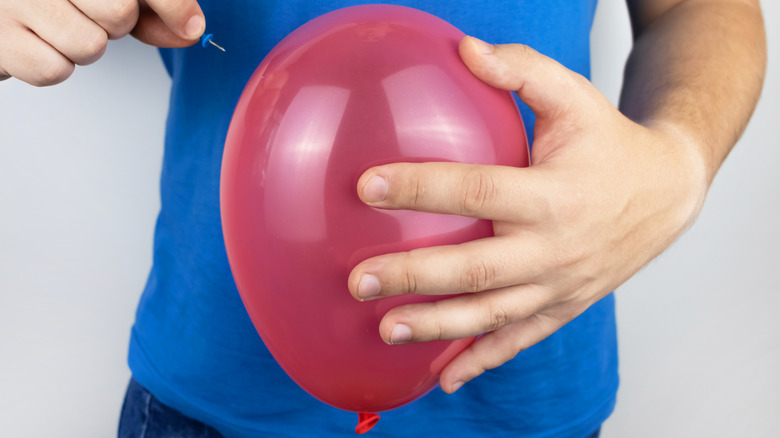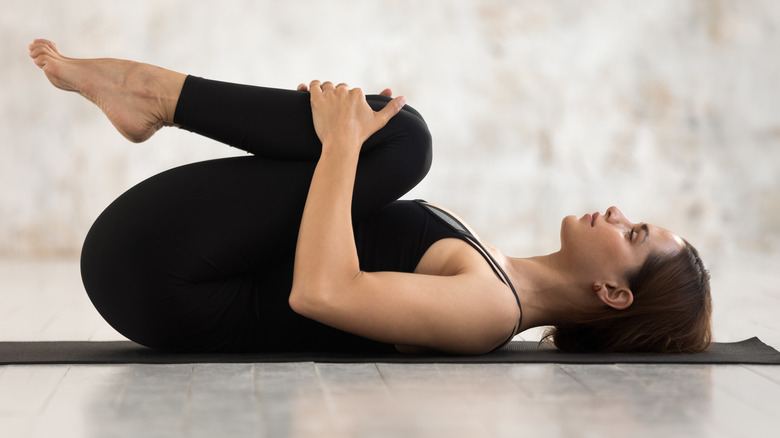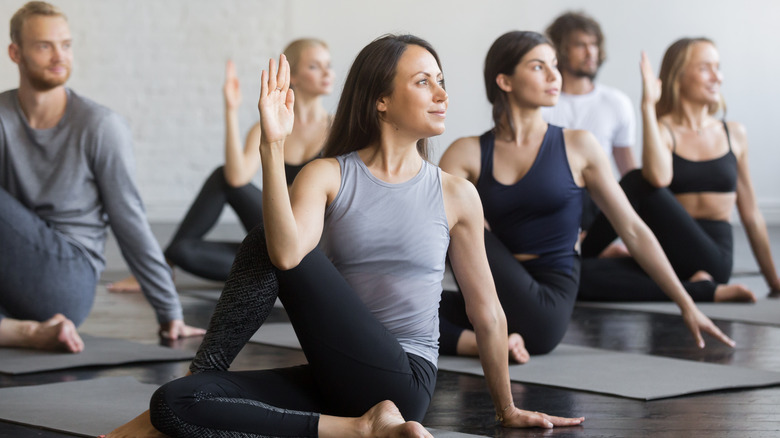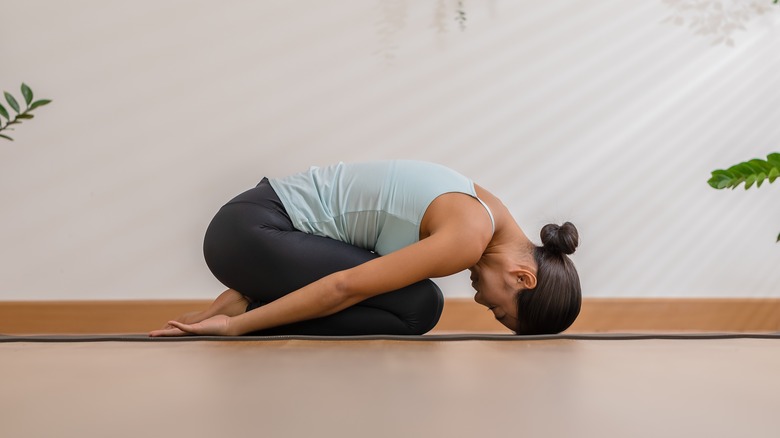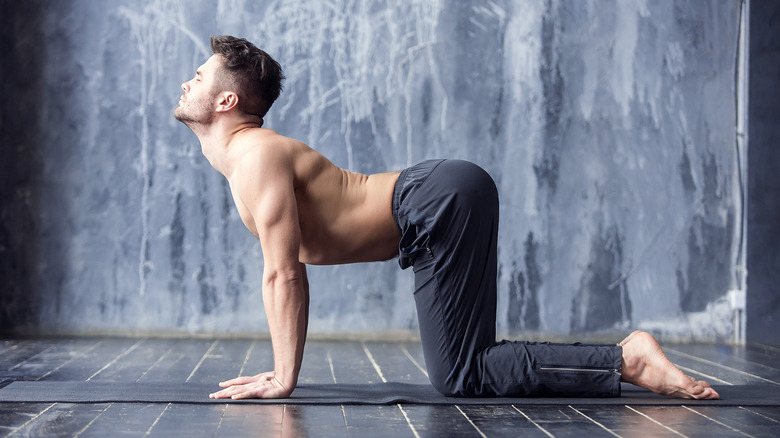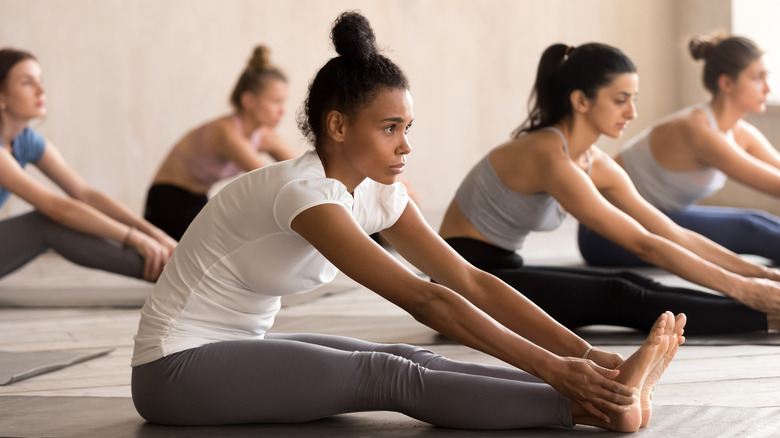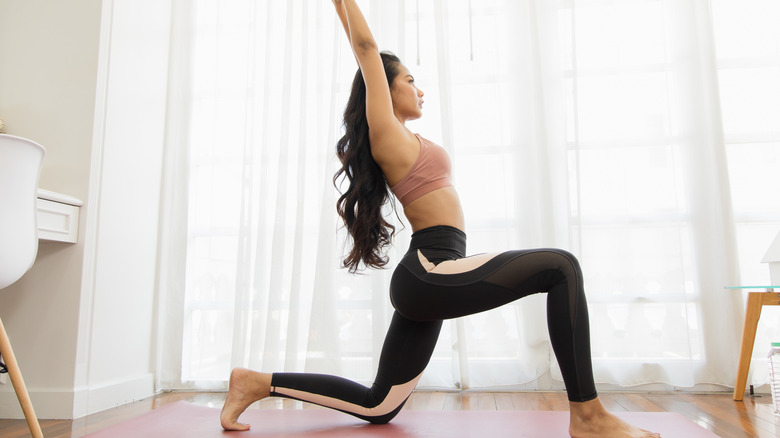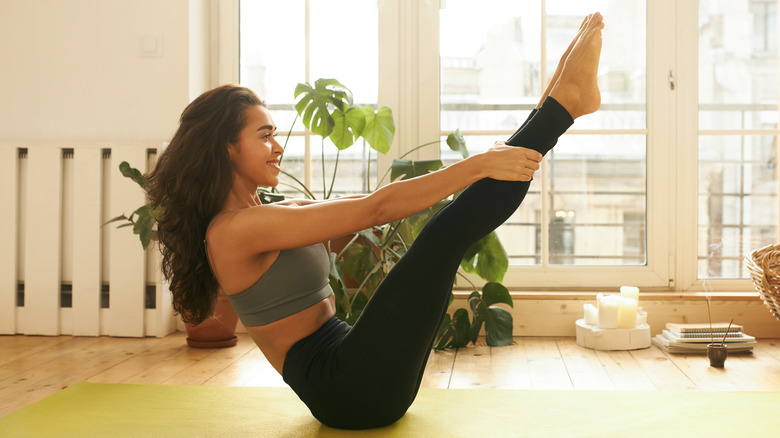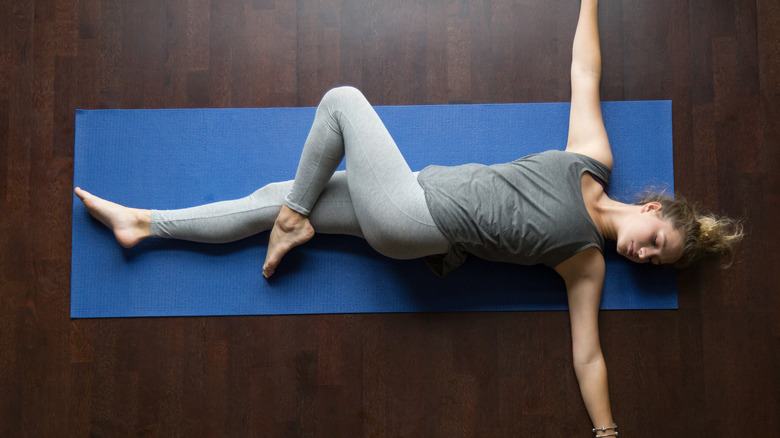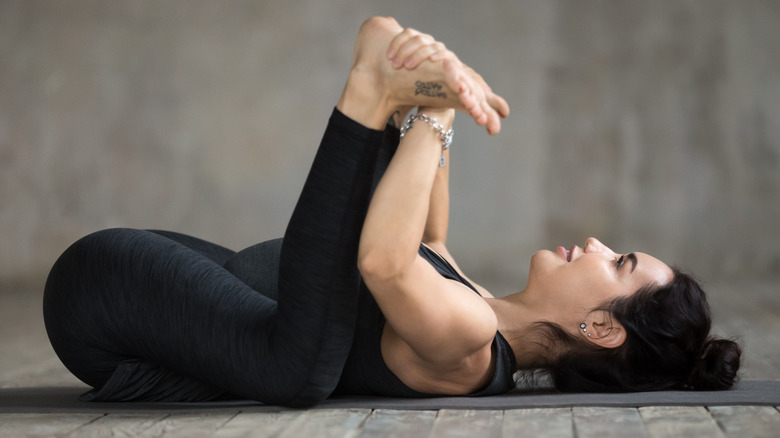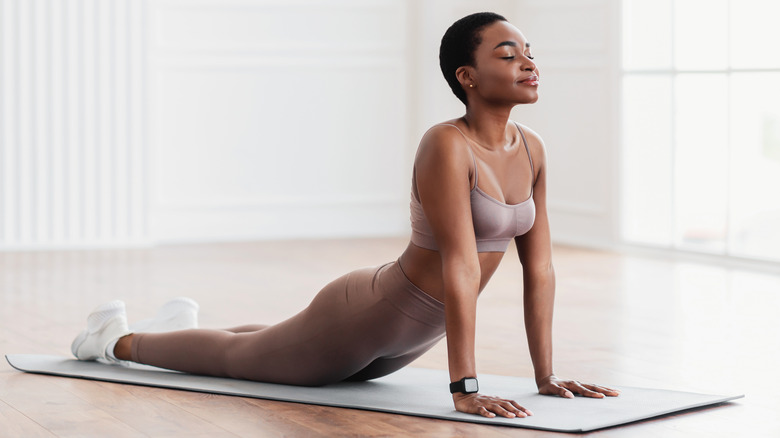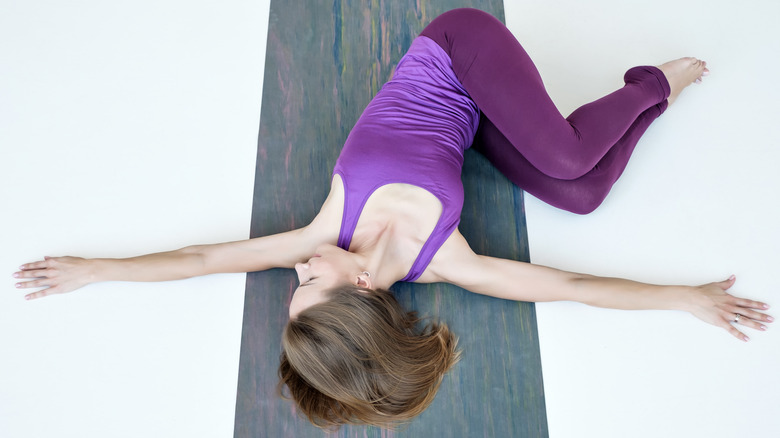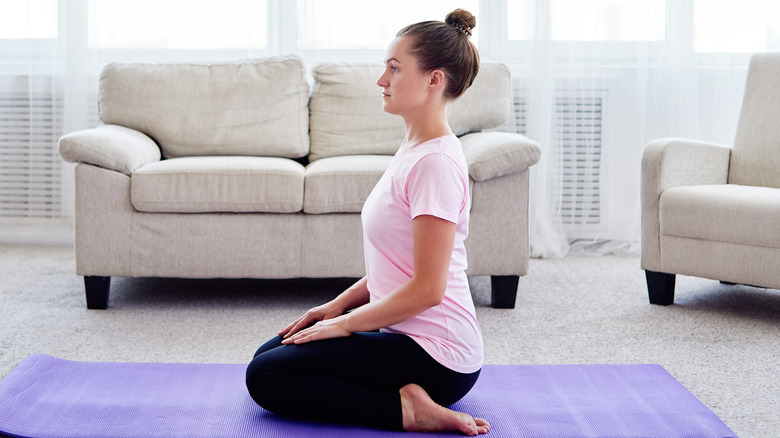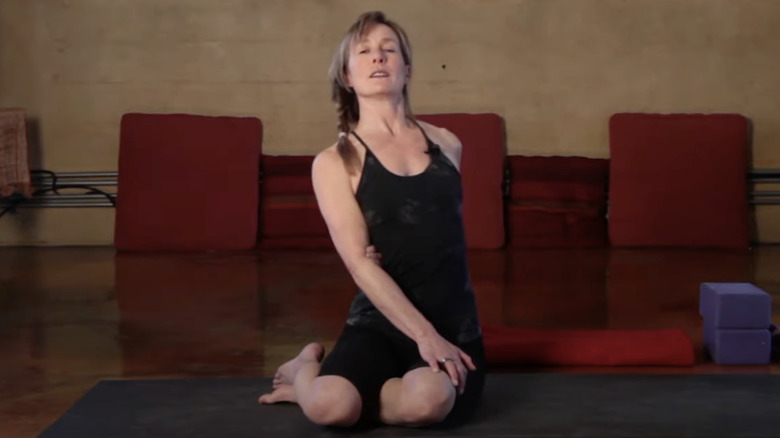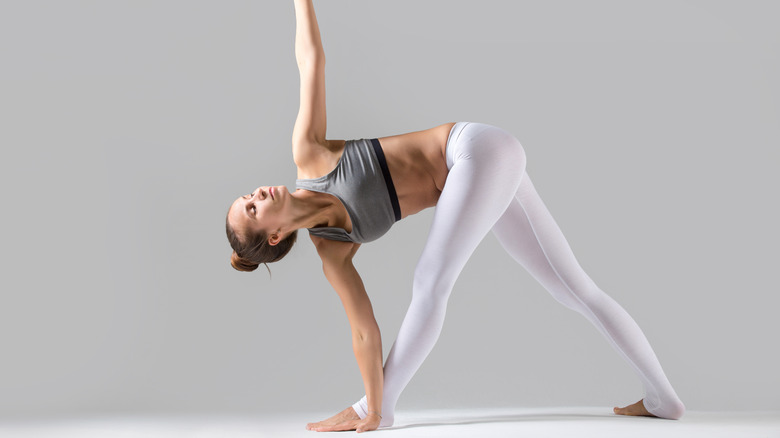Yoga Poses To Help Ease Bloating
The benefits of yoga seem to know no bounds. The exercise practice seems to have almost too many health positives to count, with regular yoga being found to help with achieving more restful sleep, improved strength and flexibility, easing stress, less back pain, and managing the symptoms of arthritis, according to Johns Hopkins Medicine. Surely that's enough to go on, right?
Well, as it turns out, it could be beneficial for one more thing: Your stomach. Bloating can be a common issue for a lot of people, with approximately one in seven U.S. citizens experiencing bloating regularly, according to a survey published in the American Journal of Gastroenterology. And whether that's due to eating specific foods or just having a big meal, one way to ease your bloating could be yoga. With its frequent involvement of the core of your body and its ability to relax your muscles, yoga (and certain poses, in particular) could give you some welcome relief from trapped gas and bloating (via Healthline). It may even assist in reducing bloating symptoms if they're due to a chronic health condition like IBS, according to research published in Evidence-Based Complementary and Alternative Medicine.
So what are you waiting for? Grab your mat, and let's show that bloated feeling the door with these key yoga poses.
Knees to chest (Apanasana)
Of all the yoga poses to help with bloating, knees to chest might be the best. Apanasana, which is also known as the "wind-relieving pose" (per Women's Health), does quite literally what it says on the tin. Knees to chest pose provides your belly with a gentle massage, thereby allowing any wind to move through your body more effectively, relieving bloating while also invigorating your circulation and relieving lower back stress (per Spotebi).
Begin the pose by lying on your back, with your hands out by your sides and your feet planted on the ground, knees bent. Take your hands and grab the top of each knee, and then gently pull your knees into your chest. Continue to breathe as you feel the stretch activating through your lower back while ensuring that your spine remains long and your lower back doesn't arch. Try to hold the pose for a minimum of 30 seconds and up to a minute, before allowing your legs to return to the mat and planting your feet back on the floor. Then, if desired, repeat the pose.
Half Lord of the Fishes pose (Ardha Matsyendrasana)
This pose has way more going for it than just a very cool name. Half Lord of the Fishes pose, also known as Ardha Matsyendrasana, is a twisting pose that your digestive system will love. Operating through the center of the body, this pose may improve your digestion while giving your internal organs a good massage, and that's all in addition to giving your spine, hips, shoulders, and neck an awesome stretch (per Everyday Yoga).
Sit on your mat with your spine long and your legs flat in front of you, using your arms to gently stabilize your body by your sides. Bring your legs into a bent position, and then thread one of your legs under the other one, so that it's flat on the floor with your foot touching the opposite glute. From here, raise the opposite arm to your upright leg and bring it down on the outside of the knee, so that your body comes into a twist. Keep your arm bent, with your other arm remaining on the floor. Continue to breathe, and each time you breathe out, try to deepen the twist even more. Hold the pose for a maximum of one minute before gently untwisting your body and returning to your original sitting position. Repeat the twist in the other direction.
Child's pose (Balasana)
The child's pose is one of our favorite yoga poses, and not just because it's deeply, endlessly relaxing. A restorative position, child's pose encourages greater length through your spine and stretches your back and ankles, while also helping to open your hips, states WebMD. And the folded position of the pose means you're putting gentle pressure on your stomach, which can assist in easing bloating and keeping your digestive system in check (per The Healthy).
Begin by kneeling on your yoga mat, with your hands by your sides. Your butt should be against your heels, with your spine straight and long. From here, start to hinge forward at the waist, allowing your upper body to come towards the mat, placing your hands out in front or keeping them by your side body. "If arms are by your side, it's soothing and if they're reached out it's more active. Both are de-bloating," states certified yoga teacher Keri Gans, who's also a registered dietitian nutritionist. When your upper body reaches its lowest point while folded over your legs, hold the position for up to 30 seconds, continuing to breathe as you do so. Then, slowly return your body to its starting position.
Cat-cow (Chakravakasana)
Cat-cow, or Chakravakasana, is an active yoga move that does wonders for your body. Aside from working through your spine and your abs, it's also a seriously helpful pose for folks who are experiencing bloating. "The cat/cow pose reduces belly bloat as it stretches and contracts the abdominal region, all in one move," states yoga and Pilates instructor Kristin McGee (via Active).
The cat-cow pose has two distinct stages, and it's important to keep focused as you move through both. Start by moving into a neutral all-fours position on a yoga mat, with your legs under your hips, your arms under your shoulders, and your back flat. Your gaze should be cast down and forward, with your neck long and relaxed. Then, breathe in and gently start to lift your head, while allowing your stomach to drop down towards the mat, introducing a curve in your spine. This is the "cow" pose. Hold the position here for a second or two, ensuring that you're not pushing your spine into a curve too much, and then slowly start to arch your back, with your head and tailbone dropping down as you do so while exhaling. This is the "cat" pose. Continue to cycle through the two poses, keeping your movement easy and fluid, roughly 10 times before resting.
Seated forward bend (Paschimottanasana)
Yoga teachers may make the seated forward bend (or Paschimottanasana) look easy, but for the majority of people, they can be challenging, says yoga teacher Barbara Benagh (via Yoga Journal). This pose is definitely worth mastering, though. Not only does the seated forward bend provide an excellent stretch through your spine and the back of your lower body, but it can also help to stimulate your digestive system, reducing bloating (per Healthline).
Start by sitting on your mat with your legs out in front of you, flat on the floor, and your torso upright. If it helps, you can place something under your butt (like a small cushion) for stability. Put your hands on either side of your body, and while flexing your toes towards you, start to fold your body down over your legs, moving from your hips. Breathe out as you do so. As your body continues to come down over your legs, move your hands to your feet, either putting them on top of your legs or holding your feet. Only move down as far as your body allows — don't push the pose, as doing so might risk pain or injury. Continue to breathe as you hold the pose, moving down further if possible on each exhale, before returning to a sitting position.
Crescent lunge (Anjaneyasana)
The muscles and organs are in a delicate balance with each other, and what might be surprising is how much one can affect the other. Interestingly, this is the case when it comes to your digestive system. "Tight psoas muscles can compete with organs and cause your belly pain and bloating," explains yoga instructor Kristin McGee (via Active). However, by practicing a crescent lunge or Anjaneyasana, "you are opening up the front of the body, stretching your abs, hip flexors and psoas muscles," and therefore helping to ease that bloating feeling, states McGee.
You can begin this move by getting onto all fours or a high plank, with your body in a straight line from heel to head. Step one of your legs up and through, planting your foot between your hands, and with your other lower leg flat on the mat, raise your arms into the sky. Gently lean your upper body back, feeling the stretch through the front of your hips, as you breathe into the position. Ensure that your shoulders don't start to bunch up towards your ears. Hold the position as you cycle through around eight breaths, before gently returning your hands to the ground and resting.
Boat pose (Paripurna Navasana)
The boat pose may not be for the faint-hearted, but its benefits are vast. Boat pose, or Paripurna Navasana, is not only excellent for building strength in your hip flexors, spine, and core muscles, but it may also assist in making your digestion better, according to Ekhart Yoga. Given that digestive issues are one of the key causes of bloating (per the NHS), mastering this move could be beneficial for your belly bloat.
Sit on your mat with your back upright and your feet planted on the floor in front of you, knees bent. Take your hands and place them on the outside of each knee. Engaging your core and your back muscles, breathe in and lean back so that you're on your sitting bones. Simultaneously, lift your feet off the ground and up into the air until they're roughly parallel with your knees, while also moving your hands away from your knees and extending them out in front of you. If you want to challenge yourself even further, you can extend your legs fully. Breathe while holding this pose, for a minimum of two breaths and a maximum of ten, before gently bringing your feet back to the ground and resting.
Supine spinal twist (Supta Matsyendrasana)
We love a twist, folks. Seriously, love 'em. And the supine spinal twist (Supta Matsyendrasana) might be the king of them all. A supine spinal twist is especially good for bloating and encouraging better digestion, and could be instrumental in reducing constipation, according to Healthline. And the twist itself supplies an awesome stretch through your lower back and side body while giving your spine a little bit of love, assisting in generating better mobility.
Start by lying on your mat in a semi-supine position, with your back flat on the ground and your knees bent, your feet planted firmly. From here, bring one of your bent legs up towards your chest, while straightening the other leg out and laying it on the ground fully. Allow your body to rock to the straight leg side, bringing your bent knee over the leg, and using your hands to gently encourage it over. You can also use one hand to stabilize your body by placing it on the floor, while your other hand enables the stretch through your lower back by remaining on your bent knee. Don't force your knee down, though — just let it fall over the straight leg. Breathe in and out for a cycle of five breaths, before untwisting and repeating in the other direction.
Happy baby (Ananda Balasana)
If anyone can tell us that doing happy baby, or Ananda Balasana, doesn't put a smile on their face, we're going to safely assume that person is a killjoy. Okay, that may be a stretch, but honestly, this pose is one of the most joyous yoga moves you can do. And besides its relaxing and jovial nature, there's another reason why we love the happy baby pose: It's great for moving gas through your system, and may be particularly helpful for individuals who experience bloating during pregnancy (per Medical News Today).
Lay on your back, with your knees bent and planted on the mat and your hands on your stomach. Gently lift your knees up and towards your upper body, bringing your feet off the mat as you do so, and grab your feet with your hands (or use a yoga strap if you can't reach that far). Keeping your feet grasped in your hands, gently rock from side to side, with your legs outstretched, channeling a giggling infant in their cot as you do so. If you're pregnant, you should try not to do this move for too long, and limit the amount of time you spend lying on your back.
Cobra pose (Bhujangasana)
Most people know how satisfying it is to stretch out the abs, and the cobra pose, or Bhujangasana, allows you to do that effectively. But that core stretching won't just make you feel good after a few rounds of crunches. "Cobra pose lengthens your abdominal wall, which can stimulate more efficient digestion and relieve bloating," states Yoga Strong founder Jason Deutchman (via Bustle). This is on top of yoga's more general benefits to digestion and bloating, thanks to its ability to "reduce stress and bring more balance to the body, which allows for all systems — including the digestive system — to work at an optimal level," says YogaRenew Teacher Training director Kate Lombardo.
Begin by laying face-down on your mat, with your legs flat behind you and your toes pointed. Place your hands on either side of your body, palms flat on the ground, at shoulder height. Your elbows should be tucked into your body. From here, push your upper body up off the mat, with your head facing up and forward, feeling a stretch through your abdominal muscles. Hold the cobra pose for up to ten breaths before releasing back down to the mat.
Two-knee spinal twist pose (Jathara Parivartanasana)
Any exercise that moves the center of our body will move the organs around a little, too. But this isn't necessarily a bad thing, and in yoga practice, this could have some benefits. The two-knee spinal twist pose (or Jathara Parivartanasana) uses a twisting motion to not only stretch out the muscles but stimulate and stretch the torso organs, thereby promoting better digestion and less bloating (per Healthline).
Unroll your yoga mat and lay down on your back, with your feet flat on the floor. Bring your knees up a few inches, so that your feet are hovering off the ground, your thighs are at a 90-degree angle to your upper body, and your calves are parallel to the ground. Place your arms straight at either side of your body to stabilize you in this position. Then, while breathing out, allow your knees to fall to one side of your body, twisting through your spine and torso as you do so. Make sure your knees and feet don't separate as you do so. Take your hand on the side your knees have twisted to, place it gently on the outside knee to deliver a deeper twist, and then turn your head in the opposite direction. Breathe in this pose for around 30 seconds before returning your body to the starting position, and repeat on the other side.
Hero pose (Virasana)
Let's be real, we all wanna do a move called "hero pose." It just kinda makes your day a little better, right? And not only will the hero pose (or Virasana) make you feel as though you just saved a kitten from up a tree without having to grab your ladder, but it can also ease your digestion and a bloated feeling, thanks to the upright kneeling position it requires (per Rennie). Additionally, hero pose delivers a great stretch through the muscles in your lower body, lengthening your quads and shin muscles and stretching your ankles.
Begin by kneeling on your mat, with your thighs upright, and your feet and lower legs a little wider than hip distance, as Yoga Journal says. While breathing out, gently sit your butt back so that your butt moves back between your calves. If you can, rest your glutes on the floor between your legs, while ensuring that your chest remains open, your neck is upright, and your gaze is forward. Place your hands on your knees in front of you. If your flexibility doesn't allow you to sit right back, it can be helpful to place a yoga block or a folded towel in between your lower legs.
Bharadvaja's twist (Bharadvajasana)
We'd be pretty jazzed if we had a yoga move named after us, y'all. And we're not exactly sure that's how the guru Bharadvaja felt when the pose Bharadvaja's twist was named after him (per Yogapedia), but what we are sure about is this pose's benefits. Bharadvaja's twist, or Bharadvajasana, is a movement that massages the organs in your torso (which may help with digestion and bloating) while also providing your spine with a twist to assist its mobility (per Ekhart Yoga).
Start in a seated position with your legs extended in front of you, and then bend your legs back and to one side as your weight shifts to the glute on the other side of your body. Your feet should be resting against each other, with your ankle against the inside of your other foot. Keeping your spine straight and long, twist to the other side that your legs are bent to, placing your outer hand against the floor to stabilize your body and the top of your other hand against the outside of your thigh. Continue to breathe as you hold this pose, deepening the twist with each breath out. Hold for around five breaths, before gently untwisting and returning to a sitting position. Repeat on the other side.
Revolved triangle (Parivrtta Trikonasana)
We thoroughly enjoy it when exercise and geometry collide (look, we all have our passions, and this is ours, okay?), and the revolved triangle pose is a premium example of this match made in heaven. Revolved triangle, or Parivrtta Trikonasana, incorporates a twisting motion that your digestive system will love. "Twists are great for stimulating blood flow to the digestive system," explains yoga teacher and lululemon ambassador Annie Clarke (per Marie Claire). This twisting movement is beneficial for relieving bloating and other digestive issues like constipation.
To do the revolved triangle, you'll first have to get in a lunge, according to The Healthy. Stand with your feet hip-width apart, and then take a big step forward, moving down into a lunging position. Then, straighten out your front leg and flatten your back foot on the ground, bringing it forward a little if necessary. Your legs should be in a scissor-like position. Hinge forward at the hips and place the opposite hand to your front leg on the inside of its foot. Then, twist your torso in the direction of your front leg, while extending your other hand toward the sky. Breathe through the twist, for a maximum of ten breaths, before releasing the twist and repeating it on the other side.

